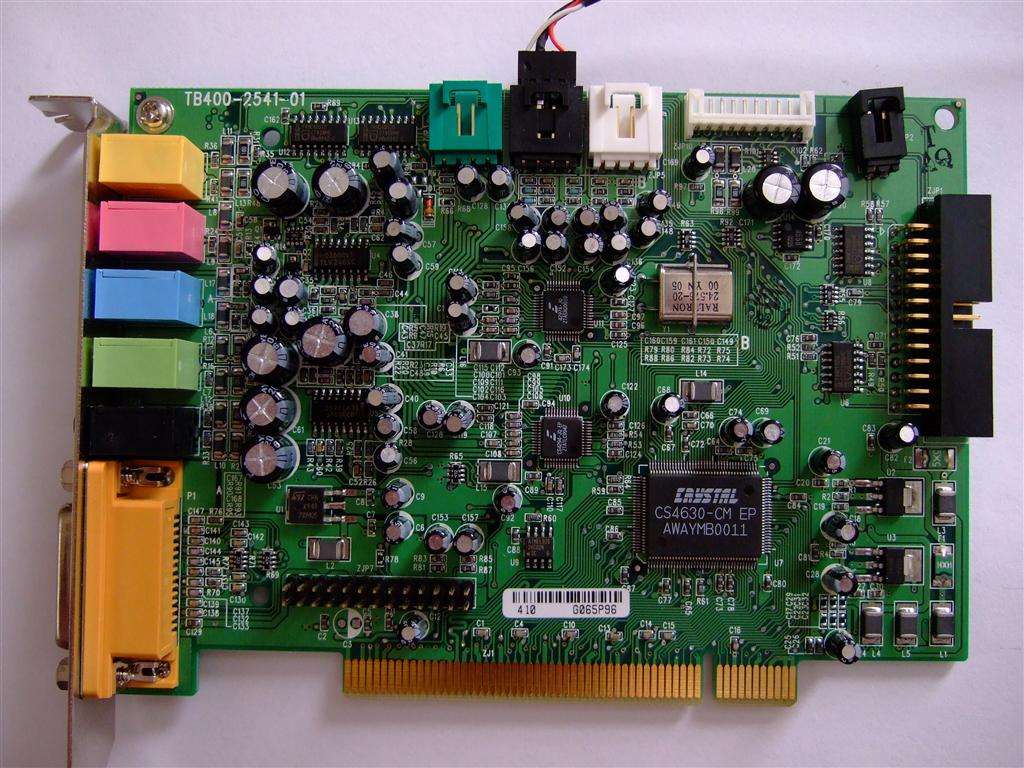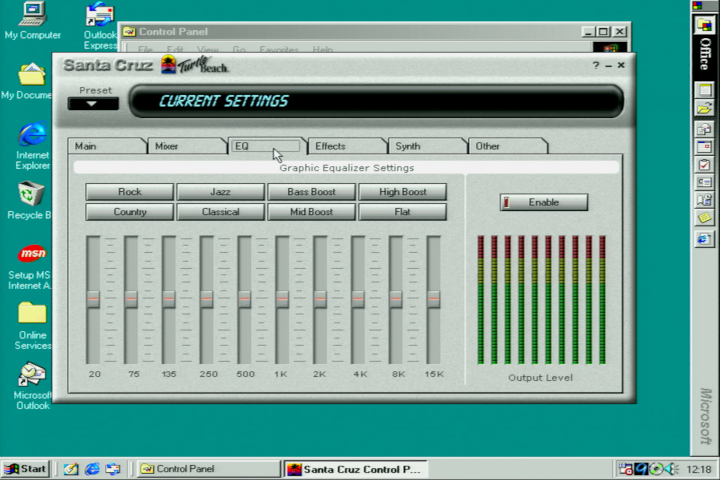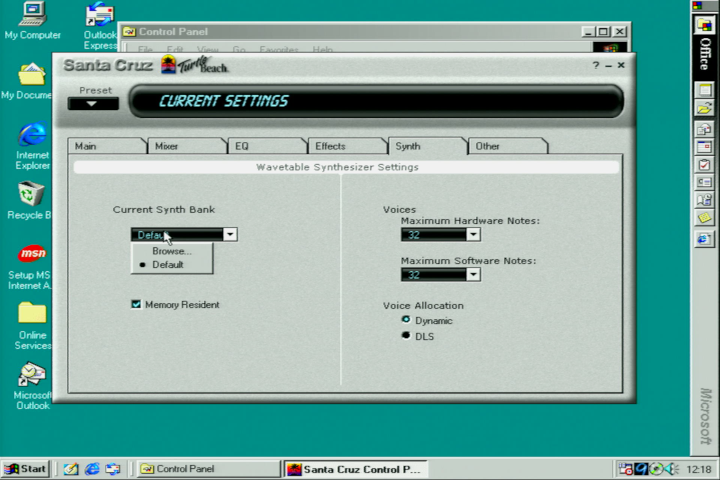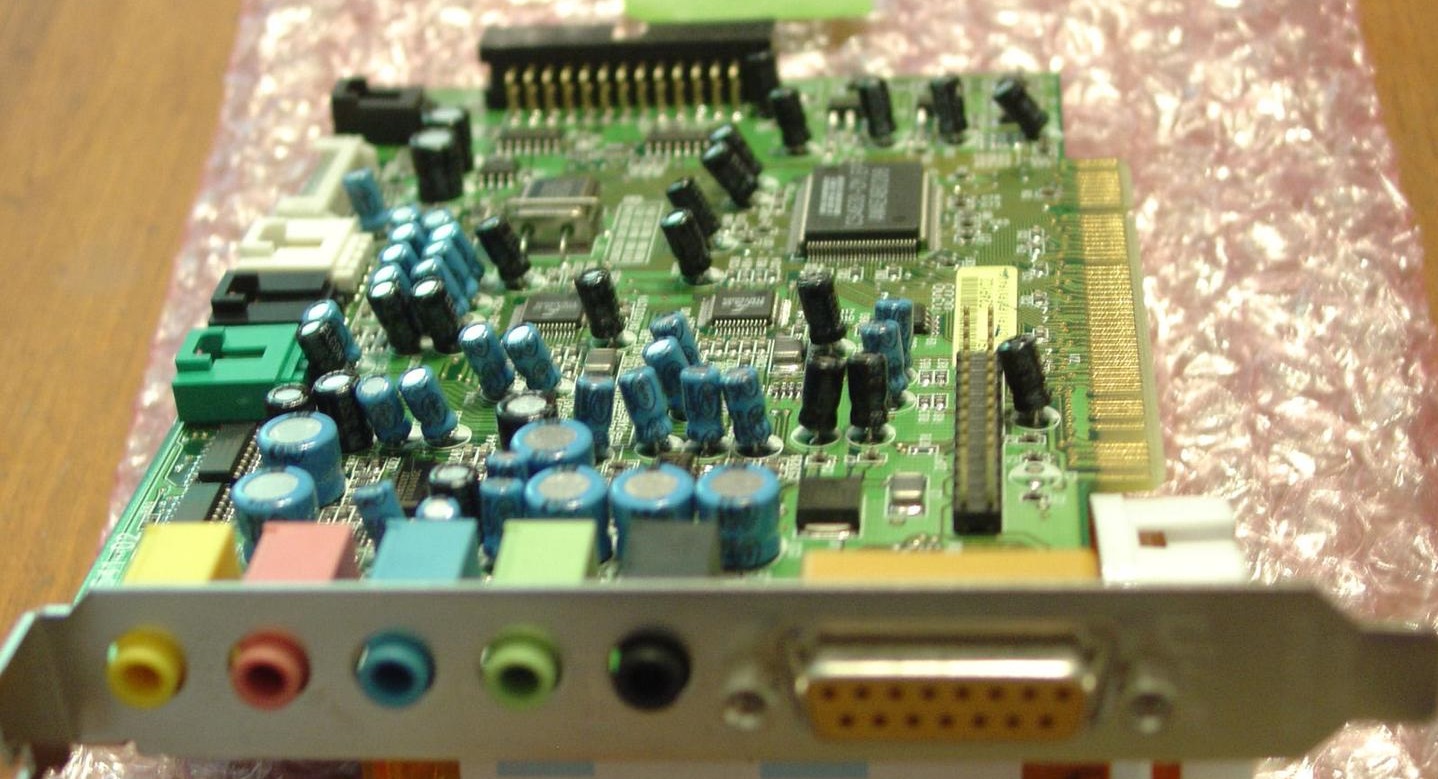Turtle Beach Santa Cruz
The Santa Cruz arrived around the time that Creative Labs launched their Live! 5.1 series, Philips released the Acoustic Edge, and Hercules had the Game Theater XP. Similar in specs, the Santa Cruz was a 6-channel PCI sound card based on the Crystal CS4630 SoundFusion digital signal processor.
|
Released | Late 2000 |
| Bus | PC | |
| FM Synth | (embedded in Crystal) | |
| Audio Codec | Crystal CS4630 SoundFusion | |
| Standards | DirectSound, DirectSound3D, EAX 2.0, I3DL2, Aureal A3D 1.0, and General MIDI. | |
| Ports | Mono Mic In, Stereo Line In, Front Speakers, Rear Speakers, VersaJack, Game/MIDI port, Santa Cruz Upgrade connector. | |
| Wavetable | Onboard with software soundbanks + Wavetable header (Windows only) | |
| CD-ROM | None | |
| Part # | TB400-2541-xx / TBS-3400 | |
| Price | At launch: Autumn 2000: $80 (street price) Jan 2001: $100 |
|
| See Also |
The CS4630 provided support for AC97, DirectSound, DirectSound3D, EAX 2.0, I3DL2, Aureal A3D 1.0, and Sensaura 3D positional audio.
Its onboard wavetable synthesizer and effects processor provided up to 64 hardware channels and used software sound banks - the card has no ROM chip with stored samples. An 8 MB soundbank was included with the driver software. Other soundbanks in the .DLS format could be loaded via the Turtle Beach Control Panel. Legacy DOS compatibility could be enabled in the Control Panel which added a driver that supported Sound Blaster when running in both DOS mode and real mode - this uses DDMA.
One thing unique to the Santa Cruz is an additional jack on the faceplate called the VersaJack. This can be configured via software to act in three different ways: an additional analogue stereo line-in, analogue line out, or digital out. Setting this up can be done via the excellent Control Panel with changes happening immediately (no need for a reboot).
Interestingly for a card this late, it does come with a wavetable header, though apparently it only works in Windows. This header is designed to work with the Turtle Beach Cancun wavetable daughterboard (64-voice, 350 GS instruments and 15 percussion with 5 MB ROM). Also unique is the Santa Cruz Upgrade connector on the far right-hand side of the board which I believe is used to connect an optional coaxial / optical interface daughterboard, but I've not come across one of these.
On the top of the card are five more ports, which from the left are: TAD IN/OUT (mono modem audio), CD IN (stereo CD audio), AUX IN (stereo from a 2nd CD-ROM or DVD), a headphone/MIC header, and CD Digital IN (stereo digital output from a CD-ROM)
For 3D audio support, the card is compatible with Aureal A3D 1.0 and 2.0, EAX 1.0 and 2.0, and IA3D.
Audio performance of the Santa Cruz is supposedly very good, with a frequency response of 10 Hz - 120 kHz and a SnR of >= 96 dB on the analogue mixing side, and 10 - 18 kHz and a SnR of >= 90 dB on the digital side.
The CD-ROM included with retail versions of the card included RecordingStation, SoundCheck (a utility to test the digital audio and MIDI features to be sure it's all working), and Sensaura Virtual Ear. It also contained limited demo versions of four Voyetra applications: AudioStation LE, AudioSurgeon, MusicWrite and Digital Orchestrator Pro.
The Santa Cruz was sold with Dell's Dimension XPS B Series of desktop PCs in 2000, and was also sold as the VideoLogic SonicFury in the UK.
Board Revisions
Only boards TB400-2541-01 and TB400-2541-02 are known, with no discernible differences between them (likely just the odd change in capacitor values or similar). The '02' revision has different silkscreen markings on the rear, with the addition of some Chinese writing denoting OEM variants of the card. Also, the '02' revision is missing 7 'fingers' on the PCI expansion connector where the '01' revision had them all present, indicating that the '02' revision was probably a mildly cost-reduced version.
Competition
The Santa Cruz competed directly with other 5.1 surround sound cards in 2000, including the Philips Acoustic Edge and Creative's Sound Blaster Live! 5.1 series
In the Media
The card is similar to the [Sound Blaster] Platinum 5.1 in terms of features and connectivity. In addition to its twin analog ports, the Santa Cruz sports a 1/8-inch mini jack called the 'VersaJack', which fulfills several roles. It can output 5.1 sound like a standard digital-out port; it can handle analog output for a center channel/subwoofer or headphones; and it can even accept a standard analog input. The best part is that the output for the Versajack is toggled in software, so you can have quad surround speakers connected to the dual analog-outs, a pair of headphones connected to the Versajack, and then switch between the two without crawling behind your PC.
Other settings are just as easy to configure, with a single control panel letting you tweak almost every feature. And unlike Creative's card, there's no need to click through endless menus and option boxes to change the settings.
The Santa Cruz uses Sensaura's MacroFX to fool you into believing you're getting 3D positional audio with just two speakers or headphones. There's also a confusing utility for fine-tuning the 3D algorithms according to your specific head shape (for times when you're using headphones). We found that the Sensaura MacroFX edged the Live! card in subjective listening tests, but oddly, the Live! produced better sound in LucasArt's A3D-only title Jedi Knight when playing through quad speakers. The Santa Cruz sounded slightly better when upmixing stereo signals to quad and 5.1 speakers, but we still prefer basic stereo output to the ersatz surround-sound modes on both the Santa Cruz and Platinum 5.1 cards.
If this were a standalone review, the Santa Cruz would rate very high. But because other cards here offer better software bundles and hardware features, the Santa Cruz is a bronze medal winner."
Maximum PC, Jan 2001
Based on the same Cirrus Logic Crystal 4630 SoundFusion DSP that powers the Hercules Game Theater XP, the Santa Cruz' sound quality is nearly identical to that of the Hercules board and a match for all but the best sound boards on the market. It boasts a generous selection of features such as microphone echo-cancellation, hardware MP3 decoding, and four-channel recording, and its intuitive control panel adds useful functions such as a ten band equalizer and independent pan-and-fade controls for a real-time effect. The most distinguished feature is its multipurpose VersaJack connector, which can act as various in or out connectors.
The Santa Cruz ships with Turtle Beach's trusty suite of music composition software, MP3, and waveform editing applications, which remain competitive. There's no Dolby Digital decoder or DVD player, but like all cards here, the Santa Cruz can pass undecoded 5.1 signals through its S/PDIF jacks to any receiver or speaker system that contains a decoder.
The Santa Cruz lacks some new features offered by boards such as the Game Theater XP and Sound Blaster Audigy. But if you don't need a breakout box, optical I/O, or remote control, this flexible card is a viable alternative to the pricier 5.1-channel boards here."
PC Magazine, 29 Jan 2002
Setting it Up
Given its time of launch, the Santa Cruz is designed for use in Windows, but despite it being a PCI card it does have some DOS compatibility. Here are some shots of installing the Windows drivers (v4.12.01.4081-2921):

The Windows 98 WDM (Windows Device Manager) installation adds two devices under Sound, video and game controllers.


The Turtle Beach Control Panel is really rather good:

The included Sound Check utility verifies that your Santa Cruz is properly configured and runs an audio test. It takes about 1 minute to go through all four tests.
When you finish it writes the card's settings and status to the onboard EEPROM on the card:
By default, the card is not configured for use in DOS at all, but if you select the Enable Legacy DOS Game Support option on the "Other" tab, this installs a third device in Device Manager called Santa Cruz Game Device:
When running in DOS mode (either within Windows or in "Real Mode" DOS), it initialises the card with a DOS program called TBCDOS.EXE which is installed under C:\Windows\TBCDATA.
I was unable to get much success running DOS "Real Mode" games with this card, but had concerns about the resource usages with the v4081 driver.
I then installed an updated driver, version 5.12.01.4193-3267 - instead of the two devices I had before enabling 'legacy DOS support', I got three devices: Santa Cruz(tm), Santa Cruz(tm) Game Port, and Santa Cruz(tm) WDM Interface. The first device was assigned to use IRQ 7. Strangely, the Santa Cruz Control Panel is different in this version, and *does not* provide an option to "Enable Legacy DOS Game Support". I rechecked the folder C:\Windows\TBCDATA, and sure enough, TBCDOS.EXE is not a part of this latest driver set:
I went back to the files that make up the old 4061 driver set, and ran TBCDOS as follows:
TBCDOS /A220 /M1 /I7
and it ran the initialization utility without error. Running several DOS games in Ad Lib, Sound Blaster, and Sound Blaster Pro mode worked just fine in real mode DOS. Despite hours of tweaking and testing, I was unable to get the wavetable (both the embedded one in the CS4630 and a daughterboard attached to the wavetable header) to be detected in DOS. Using this latest 4193 driver worked flawlessy in Windows, so if you want the best of both worlds (DOS and Windows), use the 4193 driver for the Windows portion and run the TBCDOS from the 4061 drivers for real mode DOS.
Downloads
All driver versions start with 5.12.01.xxxx. It is believed that v4193 was the final driver version for the Turtle Beach Santa Cruz.
Operation Manual The user guide and installation manual. |
Windows 9x/ME Drivers This is the Windows 98 WDM (Windows Device Manager) driver, including Turtle Beach Control Panel. (28 MB). |
Windows 9x/ME Drivers
This is the Windows 98/ME WDM (Windows Device Manager) driver, including Turtle Beach Control Panel. (20 MB). |
Windows 9x/ME Drivers This is the Windows 98/ME WDM (Windows Device Manager) driver, including Turtle Beach Control Panel. (20 MB). |
Windows 98SE/ME/2000/XP Drivers This is the latest version from Dell who shipped the Santa Cruz with their Dimension 4x00 and 8x00 desktop PCs. |
Windows 98SE/ME/2000/XP Drivers This is the latest version from Dell who shipped the Santa Cruz with their Dimension 4x00 and 8x00 desktop PCs. |
Windows 98SE/ME/2000/XP Drivers This is the latest version from Dell who shipped the Santa Cruz with their Dimension 2x00, 4x00 and 8x00 desktop PCs. |
Windows 98SE/ME/2000/XP Drivers This is the Windows 98SE/ME/2000/XP WDM (Windows Device Manager) driver, including Turtle Beach Control Panel. |
|
Sensaura Information Tool Similar to DXDiag, this provides version details on Sensaura drivers and other related files. |
Sensaura Player3D A WAV file player that supports Sensaura 3D surround (including EAX 2.0) |
More Pictures
A revision 2 Santa Cruz
The retail box for the Santa Cruz



























